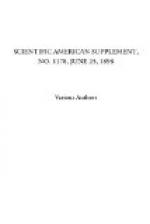Cairo, Egypt.
* * * * *
ROSE PSYCHE.
The hybrid Polyantha Rose Psyche is a seedling from the dwarf Polyantha Rose Golden Fairy, crossed with the pollen of the Crimson Rambler. Its growth and habit, though more delicate, much resembles the Rambler. It is apparently quite hardy, and is very free flowering, but we fear not perpetual. The flowers are produced in clusters of from fifteen to twenty-five, and are 2 to 21/2 inches across when fully expanded. In the bud stage they are very pretty and well formed. The color is white, suffused with salmon-rose and pink, with a yellow base to the petals. It is a real companion to Crimson Rambler.—The Gardeners’ Chronicle.
[Illustration: Rose hybrid polyantha “Psyche”—Color, Pale pink.]
* * * * *
SLEEP AND THE THEORIES OF ITS CAUSE.
The theory of the origin of sleep which has gained the widest credence is the one that attributes it to anaemia of the brain. It has been shown by Mosso, and many others, that in men with defects of the cranial wall the volume of the brain decreases during sleep. At the same time, the volume of any limb increases as the peripheral parts of the body become turgid with blood. In dogs, the brain has been exposed, and the cortex of that organ has been observed to become anaemic during sleep. It is a matter of ordinary observation that in infants, during sleep, the volume of the brain becomes less, since the fontanelle is found to sink in. It has been supposed, but without sufficient evidence to justify the supposition, that this anaemia of the brain is the cause and not the sequence of sleep. The idea behind this supposition has been that, as the day draws to an end, the circulatory mechanism becomes fatigued, the vasomotor center exhausted, the tone of the blood vessels deficient, and the energy of the heart diminished, and the circulation to the cerebral arteries lessened. By means of a simple and accurate instrument (the Hill-Barnard sphygmometer), with which the pressure in the arteries of man can be easily reckoned, it has been recently determined that the arterial pressure falls just as greatly during bodily rest as during sleep. The ordinary pressure of the blood in the arteries of young and healthy men averages 110-120 mm. of mercury. In sleep,




